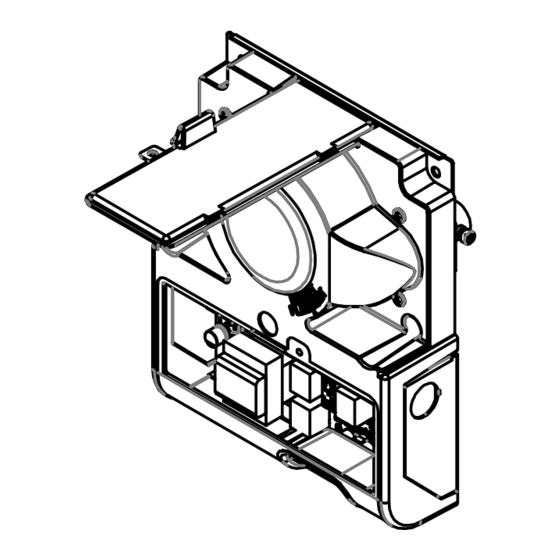
Advertisement
INSTALLATION INSTRUCTIONS: FCD-350 FOUR-WIRE DUCT SMOKE DETECTOR
These are Installation Instructions (DWG.# HA-06-445) for the FCD-350 Duct Detector configured as follows:
FCD-350
Duct Housing with the FCD-350-DH Conventional Photoelectric Smoke Detector
I. LOCATION REQUIREMENTS
To prevent false alarms the detectors should not be mounted in areas of extreme high or low temperatures, in areas where
high humidity exist, or in areas where duct air may contain gases or excess dust. The duct detector should, when possible, be
located a minimum of six duct widths downstream from a source of turbulence (bends, inlets, or deflection plates). At these
locations, air flow is less turbulent and the air/smoke mixture should be more homogenous.Refer to NFPA 90A, 72, and 101
for more information. See Figure 1.
Exception: Where it is physically impossible to locate the duct detector accordingly, the duct detector can be
positioned closer than six duct widths, but as far as possible from inlets, bends, or deflection plates
II. MOUNTING THE DETECTOR
A. DUCT PREPARATION
1. Remove paper backing from mounting template (packaged in installation kit) and affix to duct at desired location on the side or top of duct.
2. Using template as a guide, drill 4 mounting holes (3/32" diameter) for duct mounting screws (4 #12 x 1/2" sheet metal screws packaged in installation kit).
Drill or punch holes for sampling tubes in air ducts (1-3/8" diameter), using template as a guide. Clean all holes.
B. VERIFY AIR FLOW AND DIRECTION
The Duct Detectors are designed for use in ducts where the air velocities are from 1,000 to
4,000 feet per minute. See Figure 2 for sampling tube orientation to air flow direction.
C. SAMPLING TUBE ASSEMBLY (See Figure 2)
The sampling tubes may be ordered to a desired length or ordered in one of 3 standard
lengths and cut per requirements. The intake sampling tube consists of a piece of steel
piping with a series of holes drilled the entire length of the tube and should extend the
entire width of the duct. The holes must be facing into the air flow (see Figure 2). The
exhaust tube consists of a piece of steel piping approximately 7-1/2" long.
INTAKE SAMPLING TUBES STANDARD LENGTHS:
1. Cut the intake sampling tube to the desired length.
2. Firmly insert the stopper (packaged in installation kit) in the end of the INTAKE sampling tube.
D. MOUNT SAMPLING TUBES (See Figure 2)
1. Sampling tube connectors are equipped with set screws, which allow the tubes to be
mounted only in directions shown in Figure 2. Establish proper orientation
considering airflow direction.
2. Insert intake and exhaust tubes into connectors, align set screw to set screw hole in
tubes and tighten firmly.
E. MOUNT THE DUCT HOUSING (See Figure 1B & 2)
Move duct housing/sampling tube assembly to desired location. Use 4 mounting screws
(4 #12 x 3/4") sheet metal screws, packaged in installation kit) to secure the housing to
the air duct.
F. COVER REMOVAL (See Figure 1B & 2)
Remove the access hatch cover by removing tamper screw if installed, and depressing the tab.
Unscrew the 4 screws on the top of the duct housing, screws are captive in the housing. Push
the catch inside the access cover down to release the cover.
ACCESS HATCH
RELEASE TAB
G. VERIFY AIR SAMPLING (See Figure 3)
To verify proper sampling of air, use a Dwyer Model 4000 differential pressure gauge (or equivalent). See Figure 5
for gauge connections (FCD-350-DH detector not shown). The pressure differential between input sampling tube
and exhaust tube should be greater than 0.01" of water and less than 1.2" of water. Return cover and tighten captive
screws. Ensure the catch is engaged by pushing from the outside. There should be a solid green pilot indication.
Indication is independent of seal integrity.
III. ELECTRICAL INSTALLATION
A. GENERAL INFORMATION
Wiring must conform to applicable local codes, ordinances and regulations covering these types of devices.
Wire the detectors according to the engineering drawings for the particular job requirements. These detectors
are not intended for open area protection, nor should they be used for open air protection. Refer to NFPA 90A
and NFPA 72 for general and additional information on Duct Smoke Detectors concerning operation and
installation. Terminals are suitable for up to #14 gauge wire.
B. DETECTOR WIRING
With power source de-energized, wire all connections per instructions on pages 2-3. The wiring access
hatch cover can be stored at the top of the unit. Return cover before restoring power.
Bosch Security Systems, B.V. * FCD-350 Installation Instructions (HA-06-445. P/N 1700- 12670, Page 1 of 2)
FAA-325-2.5 For duct widths of 1.0' to 2.5'
FAA-325-5
FAA-325-10 For duct widths of 5.0' to 10.0'
COVER CATCH
RELEASE
Bosch Security Systems B.V.
Torenallee 49
5617 BA Eindhoven
Netherlands
For duct widths of 2.5' to 5.0'
EXHAUST TUBE
HOLE &
CONNECTOR
LOW
PRESSURE
SIZE 0 RUBBER
STOPPERS
OR EQUIVALENT
FIGURE 5. AIR SAMPLING VERIFICATION
.
INTAKE TUBE
HOLE &
CONNECTOR
HIGH
PRESSURE
TUBING
DWYER #4000 DIFFERENTIAL
PRESSURE GAUGE
OR EQUIVALENT
05/22
Advertisement
Table of Contents

Summary of Contents for Bosch FCD-350
- Page 1 Return cover before restoring power. Bosch Security Systems B.V. Torenallee 49 5617 BA Eindhoven Netherlands Bosch Security Systems, B.V. * FCD-350 Installation Instructions (HA-06-445. P/N 1700- 12670, Page 1 of 2) 05/22...
- Page 2 LEDs will flash Red to indicate an out of sensitivity condition. Smoke Test Port: The FCD-350 has a smoke port for the introduction of smoke or simulated smoke without cover removal by lifting the port tab. To test with aerosol smoke, use a inch diameter pipe (or equivalent) at the manufacturer's recommended minimum length to introduce the aerosol into the port.
















Need help?
Do you have a question about the FCD-350 and is the answer not in the manual?
Questions and answers